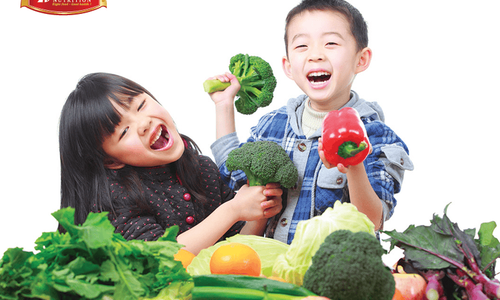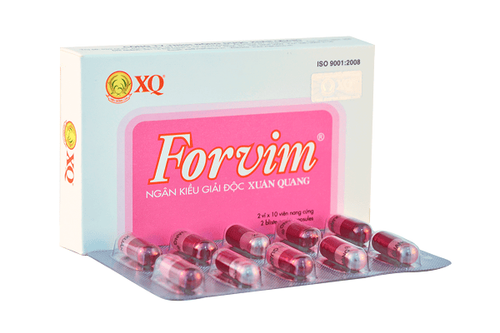This is an automatically translated article.
The article was professionally consulted with Master, Doctor Ngo Thi Oanh - Pediatrician - Department of Pediatrics - Neonatology - Vinmec Ha Long International General Hospital.Helping your baby get used to solid foods during the weaning period is very important to teach your baby to eat, to support teeth and jaw development. Besides, this process is also the first step in forming other skills that your baby will need later, such as using language.
1. When your baby is ready to get used to solid foods
During the first 6 months of life, the baby uses the iron stores in the body from the time of the fetus, combined with the absorption of breast milk or formula. As children grow older, iron stores decrease, while energy requirements increase. So your baby needs to get more iron and other nutrients from solid foods besides milk. Helping children get used to solid foods is the first step in the process of teaching them to eat, providing an enjoyable experience with new scents from a variety of foods, while helping teeth and jaws develop, as well as supporting the development of new foods. skills needed later on.To identify the appropriate time to add solid food to the child, parents can rely on the following signs of the child's development and behavior:
The head and neck are strong, can sit upright if supported; Show interest in food, such as staring intently at parents' plates; Reaching and touching food; Likes to put things in his mouth, start chewing, and move his jaw up and down; The tongue is better adjusted to move food in the mouth; Open your mouth when being fed with a spoon. Each child will have these symptoms at different times, but generally around 6 months of age. This is also the period when the baby will show signs of food allergies, if any, especially if the child has eczema or has a family history of allergies. In addition, giving solid foods to babies too early (before 4 months of age) or too late also increases the risk of food intolerance. Parents should consult a specialist if they have questions or suspect unusual signs.
2. Help your baby get used to solid foods

Trẻ tỏ ra phấn khích lúc thấy thức ăn là dấu hiệu của trẻ đang đói
Signs that the child is hungry :
Shows excitement when seeing food Leans over to parent's plate of food while sitting in a chair Opens wide mouth when given solid food to the child. Signs that your baby is not interested:
Turn your head away; Distracting attention from other things; Push the spoon out. Tighten your lips. 2.2. Food Form From liquid to solid Baby weaning can start with finely ground foods, gradually increasing the texture and then transition to mashed or soft foods cut into small pieces within a few weeks. In addition to choosing foods suitable for the baby's taste, mothers should also process foods from smooth liquid to dense, with more lumps to help the baby chew and develop oral muscles, serving later speaking skills. .

Bé ăn dặm có thể bắt đầu với thức ăn xay mịn, tăng dần độ nhám rồi chuyển sang nghiền hoặc thức ăn mềm cắt khúc nhỏ trong vòng vài tuần
Combine or alone Mother can also combine Combine a variety of foods together according to a recipe recommended by a nutritionist. However, in families with a history of allergies, they should be cautious about introducing solid foods to the baby one by one. This will help identify which solid foods your baby is allergic to or unpalatable.
Encourage your baby to eat on their own. Priority should be to prepare a variety of foods that the baby can hold with their hands, for example, cooked vegetables cut into small pieces, soft bread, toast... to encourage the baby. self-feeding and learning to chew. However, do not give your baby solid foods too quickly, but learn to get used to these foods gradually until the baby is 8 months old.
Some types of weaning nutrition for children suggested by pediatric nutritionists are:
Vegetables, such as: Potatoes, carrots, beans, bananas, apples, watermelons, avocados; Wheat, oats, bread and pasta; Dairy foods, such as: High-fat yogurt and cheese; Add oil, fat or sesame (sesame), groundnut (peanut) to solid food when processing; Cooked eggs (not raw eggs or peaches). In addition, the baby still needs to be breastfed or formula milk. Babies should be breastfed as much as possible at least until 12 months of age.
3. Notes when babies eat solids

Mẹ nên để bé ngồi vào ghế ăn cao dành riêng cho trẻ vào mỗi giờ ăn
Let your child sit in a high chair reserved for children at each mealtime; Put newspaper or plastic sheet under the baby's high chair and prepare a cleaning cloth; Give your baby a plastic spoon to feed himself; The amount of food and meals increases gradually over time; Watch for signs of hunger or fullness, appetite or lack of interest in solid foods; Do not give babies under 12 months of age any other drink except milk and cool boiled water; Do not allow children to eat cakes, sweets, or drink soft drinks before meals; Sit next to the baby while eating, talk, introduce to the child about the food being used; Do not add salt and sugar to solid foods for children to avoid creating a habit of needing spices and boring food. Cheese can be added to flour/porridge for children to enhance the salty and fatty taste without leading to excess sodium; Be patient with the "battlefield" when letting your baby eat solid foods on their own, encouraging them to discover and learn eating skills by themselves; Do not let children under 3 years of age eat hard foods such as raw carrots, nuts, meat or fish with many small bones; Always supervise the baby to promptly respond to the phenomenon of food choking. In short, from about 6 months of age on, breast milk or formula will not provide enough nutritional needs for children to continue to develop comprehensively. This is the time when parents need to help their baby make up for the lack of energy by getting used to solid foods. Solid foods for babies must be foods rich in nutrients, easy to swallow and easy to digest to supplement breast milk, not completely replace breast milk.
For children to be healthy and develop well, it is necessary to have a nutritious diet in terms of quantity and quality balance. If children are not provided with adequate and balanced nutrients, it will lead to diseases of excess or lack of nutrients, which adversely affect the comprehensive development of children in terms of physical, mental and motor skills.
The period of baby eating solid foods is an extremely important period to help children develop comprehensively. Children who do not eat properly are at risk of micro-mineral deficiencies, causing anorexia, growth retardation, malabsorption, etc. If they notice the above signs, parents should supplement their children with supportive products. The supplement contains lysine, essential micro-minerals and vitamins such as zinc, chromium, selenium, and B vitamins to help fully meet the nutritional needs of children. At the same time, these essential vitamins also support digestion, enhance nutrient absorption, help improve anorexia, and help children eat well.
Parents can learn more:
Signs of zinc deficiency in children
Micronutrient deficiency and failure to gain weight in children
Please regularly visit Vinmec.com website and update useful information to take care of your child. Take care of the baby and the whole family.
Please dial HOTLINE for more information or register for an appointment HERE. Download MyVinmec app to make appointments faster and to manage your bookings easily.













